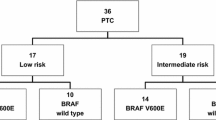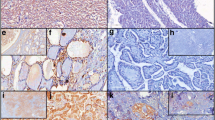Abstract
Autonomously functioning thyroid nodules (AFTN) are known to receive an increased blood influx necessary to sustain their high rate of growth and hormone production. Here, we investigated the expression of hematic and lymphatic vases in a series of 20 AFTN compared with the contralateral non-tumor tissues of the same patients, and the transcript levels of proteins involved in the control of vascular proliferation, including the vascular endothelial growth factor (VEGF) and platelet-derived growth factors (PDGF) and their receptors and the endothelial nitric oxide synthase (eNOS). In parallel, the expression of the differentiation markers sodium/iodide symporter (NIS), thyroperoxidase (TPO), thyroglobulin (Tg), and TSH receptor (TSHR) was also investigated. The data were further analyzed comparing subgroups of tumors with or without mutations in the TSHR gene. Analysis by means of CD31 and D2-40 immunostaining showed in AFTN an increased number of hematic, but not lymphatic, vessels in parallel with an enhanced proliferation rate shown by increased Ki67 staining. Quantitative RT-PCR analysis revealed an increase of VEGF, VEGFR1 and 2, PDGF-A, PDGF-B, and eNOS expression in tumor versus normal tissues. Also, higher transcript levels of NIS, TPO, and Tg were detected. Comparison of the two subgroups of samples revealed only few differences in the expression of the genes examined. In conclusion, these data demonstrate an increased expression of angiogenesis-related factors associated with an enhanced proliferation of hematic, but not lymphatic, vessels in AFTNs. In this context, the presence of TSHR mutations may only slightly influence the expression of pro-angiogenic growth factors.



Similar content being viewed by others
References
R.S. Bahn Chair, H.B. Burch, D.S. Cooper, J.R. Garber, M.C. Greenlee, I. Klein, P. Laurberg, I.R. McDougall, V.M. Montori, S.A. Rivkees, D.S. Ross, J.A. Sosa, M.N. Stan, American Thyroid Association, American Association of Clinical Endocrinologists, Hyperthyroidism and other causes of thyrotoxicosis: management guidelines of the American Thyroid Association and American Association of Clinical Endocrinologists. Thyroid 21(6) 593–646 (2011) Erratum in: Thyroid 21(10) 1169 (2011)
D. Russo, F. Arturi, E. Chiefari, S. Filetti, Molecular insights into TSH receptor abnormality and thyroid disease. J. Endocrinol. Invest. 20(1), 36–47 (1997)
A. Hébrant, W.C. van Staveren, C. Maenhaut, J.E. Dumont, J. Leclère, Genetic hyperthyroidism: hyperthyroidism due to activating TSHR mutations. Eur. J. Endocrinol. 164(1), 1–9 (2011)
F. Arturi, D. Scarpelli, A. Coco, R. Sacco, R. Bruno, S. Filetti, D. Russo, TSH receptor mutations and thyroid hyperfunctioning adenomas 10 years after their first discovery: unresolved questions. Thyroid 13(4), 341–343 (2003)
D. Russo, M.G. Wong, G. Costante, E. Chiefari, P.A. Treseler, F. Arturi, S. Filetti, O.H. Clark, A Val 677 activating mutation of the thyrotropin receptor in a Hürthle cell thyroid carcinoma associated with thyrotoxicosis. Thyroid 9(1), 13–17 (1999)
D. Russo, C. Betterle, F. Arturi, E. Chiefari, M.E. Girelli, S. Filetti, A novel mutation in the thyrotropin receptor gene causing loss of TSH binding but constitutive receptor activation in a family with resistance to TSH. J. Clin. Endocrinol. Metab. 85(11), 4238–4242 (2000)
N. Garcia de la Torre, I. Buley, J.A.H. Wass, H.E. Turner, Angiogenesis and lymphangiogenesis in thyroid proliferative lesions: relationship to type and tumor behaviour. Endocr. Relat. Cancer 13(3), 931–944 (2006)
P. Viacava, G. Bocci, M. Tonnacchera, G. Fanelli, M. De Servi, P. Agretti, E. Berti, O. Goletti, P. Aretini, M.L. Resta, G. Bevilacqua, A.G. Naccarato, Markers of cell proliferation, apoptosis, and angiogenesis in thyroid adenomas: a comparative immunohistochemical and genetic investigation of functioning and nonfunctioning nodules. Thyroid 17(3), 191–197 (2007)
M. Eszlinger, K. Krohn, R. Paschke, Complementary DNA expression array analysis suggests a lower expression of signal transduction proteins and receptors in cold and hot thyroid nodules. J. Clin. Endocrinol. Metab. 86(10), 4834–4842 (2001)
M. Capezzone, E. Morabito, P. Belletti, P. Giannasio, D. De Sanctis, R. Bruno, Increasing incidence of thyroid cancer in Basilicata: an Italian study. J. Endocrinol. Invest. 30(6), 507–512 (2007)
D. Russo, S. Bulotta, R. Bruno, F. Arturi, P. Giannasio, M. Derwahl, J.M. Bidart, M. Schlumberger, S. Filetti, Sodium/iodide symporter (NIS) and pendrin are expressed differently in hot and cold nodules of thyroid toxic multinodular goiter. Eur. J. Endocrinol. 145(5), 591–596 (2001)
D. Russo, G. Costante, R. Bruno, M. Sponziello, G. Tamburrano, M. Dima, R. Sacco, L. Giacomelli, C. Durante, S. Filetti, TSH receptor extracellular region mutations in thyroid functioning nodules: further evidence for the functional role of this region in the receptor activation. Endocrine 40(3), 492–494 (2011)
M.L. Sponziello, R. Bruno, C. Durante, M. D’Agostino, R. Corradino, P. Giannasio, E. Ciociola, E. Ferretti, M. Maranghi, A. Verrienti, G. De Toma, S. Filetti, D. Russo, Growth factor receptors gene expression and Akt phosphorylation in benign human thyroid nodules are unaffected by chronic thyrotropin suppression. Horm. Metab. Res. 43(1), 22–25 (2011)
K.J. Livak, T.D. Schmittgen, Analysis of relative gene expression data using real-time quantitative PCR and the 2−ΔΔCt method. Methods 25(4), 402–408 (2001)
C. Durante, G. Tallini, E. Puxeddu, M. Sponziello, S. Moretti, C. Logorio, A. Cavaliere, K.J. Rhoden, A. Verrienti, M. Maranghi, L. Giacomelli, D. Russo, S. Filetti, BRAF V600E mutation and expression of proangiogenic molecular markers in papillary thyroid carcinomas. Eur. J. Endocrinol. 165(3), 455–463 (2011)
G. Tallini, G. Garcia-Rostan, A. Herrero, D. Zelterman, G. Viale, S. Bosari, M.L. Carcangiu, Downregulation of p27KIP1 and Ki67/Mib1 labeling index support the classification of thyroid carcinoma into prognostically relevant categories. Am. J. Surg. Pathol. 23(6), 678–685 (1999)
M. D’Agostino, P. Voce, M. Celano, M. Sponziello, S. Moretti, V. Maggisano, A. Verrienti, C. Durante, S. Filetti, E. Puxeddu, D. Russo, Sunitinib exerts only limited effects on the proliferation and differentiation of anaplastic thyroid cancer cells. Thyroid 22(2), 138–144 (2012)
A. Tan, N. Xia, F. Gao, Z. Mo, Y. Cao, Angiogenesis-inhibitors for metastatic thyroid cancer. Cochrane Database Syst. Rev. (2010). doi:10.1002/14651858.CD007958.pub2
K.L. Kojic, S.L. Kojic, S.M. Wiseman, Differentiated thyroid cancers: a comprehensive review of novel targeted therapies. Expert Rev. Anticancer Ther. 12(3), 345–357 (2012)
G. Viglietto, A. Romano, G. Manzo, G. Chiappetta, I. Paoletti, D. Califano, M.G. Galati, V. Mauriello, P. Bruni, C.T. Lago, A. Fusco, M.G. Persico, Upregulation of the angiogenic factors PlGF, VEGF and their receptors (Flt-1, Flk-1/KDR) by TSH in cultured thyrocytes and in the thyroid gland of thiouracil-fed rats suggest a TSH-dependent paracrine mechanism for goiter hypervascularization. Oncogene 15(22), 2687–2698 (1997)
A. Jebreel, J. England, K. Bedford, J. Murphy, L. Karsai, S. Atkin, Vascular endothelial growth factor (VEGF), VEGF receptors expression and microvascular density in benign and malignant thyroid diseases. Int. J. Exp. Pathol. 88(4), 271–277 (2007)
K. Sato, K. Yamazaki, K. Shizume, Y. Kanaji, T. Obara, K. Ohsumi, H. Demura, S. Yamaguchi, M. Shibuya, Stimulation by thyroid-stimulating hormone and Grave’s immunoglobulin G of vascular endothelial growth factor mRNA expression in human thyroid follicles in vitro and flt mRNA expression in the rat thyroid in vivo. J. Clin. Invest. 96(3), 1295–1302 (1995)
S. Hoffmann, L.C. Hofbauer, V. Scharrenbach, A. Wunderlich, I. Hassan, S. Lingelbach, A. Zielke, Thyrotropin (TSH)-induced production of vascular endothelial growth factor in thyroid cancer cells in vitro: evaluation of TSH signal transduction and of angiogenesis-stimulating growth factors. J. Clin. Endocrinol. Metab. 89(12), 6139–6145 (2004)
S. Deleu, Y. Allory, A. Radulescu, I. Pirson, N. Carrasco, B. Corvilain, I. Salmon, B. Franc, J.E. Dumont, J. Van Sande, C. Maenhaut, Characterization of autonomous thyroid adenoma: metabolism, gene expression, and pathology. Thyroid 10(2) 131–140 (2000). Erratum in: Thyroid 2001 Jun; 11(6): following 609
F.T. Hall, J.L. Freeman, S.L. Asa, D.G. Jackson, N.J. Beasley, Intratumoral lymphatics and lymph node metastases in papillary thyroid carcinoma. Arch. Otolaryngol. Head Neck Surg. 129(7), 716–719 (2003)
I.M. Colin, E. Nava, D. Toussaint, D.M. Maiter, M.F. van Denhove, T.F. Lüscher, J.M. Ketelslegers, J.F. Denef, J.L. Jameson, Expression of nitric oxide synthase isoforms in the thyroid gland: evidence for a role of nitric oxide in vascular control during goiter formation. Endocrinology 136(12), 5283–5290 (1995)
I.M. Colin, P. Kopp, J. Zbären, A. Häberli, W.E. Grizzle, J.L. Jameson, Expression of nitric oxide synthase III in human thyroid follicular cells: evidence for increased expression in hyperthyroidism. Eur. J. Endocrinol. 136(6), 649–655 (1997)
J.E. Donckier, L. Michel, M. Delos, X. Havaux, R. Van Beneden, Interrelated overexpression of endothelial and inducible nitric oxide synthases, endothelin-1 and angiogenic factors in human papillary thyroid carcinoma. Clin. Endocrinol. (Oxf) 64(6), 703–710 (2006)
M. Celano, F. Arturi, I. Presta, R. Bruno, D. Scarpelli, M.G. Calvagno, C. Cristofaro, S. Bulotta, P. Giannasio, R. Sacco, S. Filetti, D. Russo, Expression of adenylyl cyclase types III and VI in human hyperfunctioning thyroid nodules. Mol. Cell. Endocrinol. 203(1–2), 129–135 (2003)
L. Persani, A. Lania, L. Alberti, R. Romoli, G. Mantovani, S. Filetti, A. Spada, M. Conti, Induction of specific phosphodiesterase isoforms by constitutive activation of the cAMP pathway in autonomous thyroid adenomas. J. Clin. Endocrinol. Metab. 85(8), 2872–2878 (2000)
A. Brunetti, E. Chiefari, S. Filetti, D. Russo, The cyclic AMP response elements binding protein (CREB) is functionally reduced in human toxic thyroid adenomas. Endocrinology 141(2), 722–730 (2000)
F. Arturi, C. Capula, E. Chiefari, S. Filetti, D. Russo, Thyroid hyperfunctioning adenomas with and without Gsp/TSH receptor mutations show similar clinical features. Exp. Clin. Endocrinol. Diabetes 106(3), 234–236 (1998)
E. Puxeddu, S. Romagnoli, M.E. Dottorini, Targeted therapies for advanced thyroid cancer. Curr. Opin. Oncol. 23(1), 13–21 (2011)
B. Corvilain, J. Van Sande, J.E. Dumont, G. Vassart, Somatic and germline mutations of the TSH receptor and thyroid diseases. Clin. Endocrinol. (Oxf.) 55(2), 143–158 (2001)
E. Nishihara, C.R. Chen, Y. Mizutori-Sasai, M. Ito, S. Kubota, N. Amino, A. Miyauchi, B. Rapoport, Deletion of thyrotropin receptor residue Asp403 in a hyperfunctioning thyroid nodule provides insight into the role of the ectodomain in ligand-induced receptor activation. J. Endocrinol. Invest. 35(1), 49–53 (2012)
Acknowledgments
This work was supported by a grant from Banca d’Italia, Fondazione Umberto Di Mario, and MIUR (PRIN-Cofin 2008). V. Maggisano is fellow of PhD in Pharmaceutical Sciences at the University of Catanzaro.
Conflicts of interest
The authors declare that the experiments comply with the current laws of the country in which they were performed and that they have no conflict of interest.
Author information
Authors and Affiliations
Corresponding author
Additional information
Marilena Celano and Marialuisa Sponziello contributed equally to this study.
Rights and permissions
About this article
Cite this article
Celano, M., Sponziello, M., Tallini, G. et al. Increased expression of pro-angiogenic factors and vascularization in thyroid hyperfunctioning adenomas with and without TSH receptor activating mutations. Endocrine 43, 147–153 (2013). https://doi.org/10.1007/s12020-012-9747-3
Received:
Accepted:
Published:
Issue Date:
DOI: https://doi.org/10.1007/s12020-012-9747-3




